
Stencils are one of the simplest yet most effective tools for adding ornamentation to textiles. With a history that dates back centuries and has its roots in many cultures, the art of stenciling is constantly being updated to satisfy contemporary standards for an enormous variety of practical applications. Stenciling has many advantages over other surface design techniques used for decorating textiles. Artists today are finding even more ways to apply the wonderful stenciling techniques to textiles, and there are many magnificent examples of this work to inspire the artist within.
Although the exact time stencils came into use cannot be pinpointed, there are examples of cave paintings dating back to 10,000 BC, where cave dwellers painted around their hands using them as a resist to create an imprint on the walls of their caves.
Stenciling exists in many different cultures around the world, and among my favorites are the Japanese stencils. Although the precise origins of stencil carving in Japan are not clearly documented, some of the first evidence of this application were found on leather armor and clothing worn by warriors in the Kamakura period ( 1185-1333). The Katazome stencils that are created from a special paper and were used primarily to decorate kimonos were very popular in the Edo period from 1603 to 1868 AD. Many fine examples of the actual stencils as well as the beautiful kimonos created with them still exist today. John Marshall currently teaches the art of making traditional Japanese stencils, and is one of the most knowledgeable people on this topic. Perhaps the most extensive collection of Katazome stencils in the United States exists at the Santa Barbara Museum of Art. Although the Japanese stencils were used primarily for the application of rice paste resists for the application of natural dyes, today we have many more options available to us.

A stencil is nothing more than a piece of material with holes cut in it through which paint or other substances can be applied for the purpose of adding ornamentation to another object. It is the simplicity of this technique that has piqued my interest as I imagined the numerous possibilities that this very basic technique presents. The results can be simple or incredibly complex, and the possibilities are unlimited.
Stenciling has many advantages over other types of surface design for textiles. The advent of clear plastic film which is strong enough to hold up to multiple uses has been a wonderful development. The plastic’s transparency allows easy placement of the images in reference to one another. The openings in the stencils and the application of paints with the sturdy stencil brushes offer lots of control to do complex shading and layering of the images resulting in really wonderful designs. In the following images you can see the great variety that can be achieved with the same stencil merely by changing the color and layout.

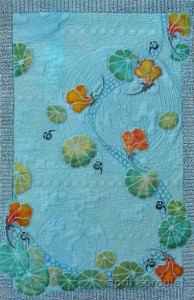
Even if you want to create your own original stencil designs, there are plenty of existing options available today to add to your collection that are very useful to have on hand for fill or background designs. Today artists are fortunate to have many choices available to them in high quality paints and other supplies to be used for the stenciling process that are especially well suited for textiles.
There are so many options available that some initial careful consideration will help you achieve the greatest success with your stenciling project. First, is the item going to be washed so that the paints will need to be permanent? Textile paints are formulated specifically for textiles: they have a binder in them to help them adhere to the fabric as well as a textile medium to give them a softer hand. They require heat setting with an iron for permanence and washability. I use water-based textile paint on all of my work, but you can also use many other items on textile such as Paint Sticks, crayons, or colored pencils. I have been very particular about using anything that changes the hand of the fabric by making it stiff or hard, but there are some really nice paints available today that provide really good coverage and opacity without any detrimental results. Always do a test swatch first so that you don’t have any unpleasant surprises later on.
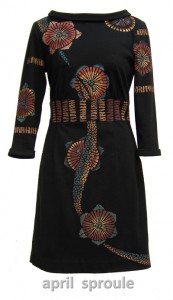
Second, if you are constructing a garment, the scale and placement of the designs are very important. It is very possible, and not that difficult to stencil an existing garment that has already been constructed. So you don’t always have to make the garment from scratch. As a general rule-of-thumb, if the garment fits as is, there is absolutely no need to take it apart. On the other hand, if the garment is an outdated style or does not fit, I will often deconstruct the piece completely and basically use the fabric as a blank to create my new garment.
Third, what are the characteristics of the fiber itself? Will the weave affect the appearance of the design you have chosen? I have painted on everything from a very lightweight pongee or habotai silk to very coarsely woven upholstery weight linen, and they all turned out very well.
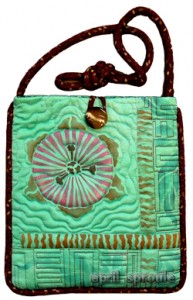
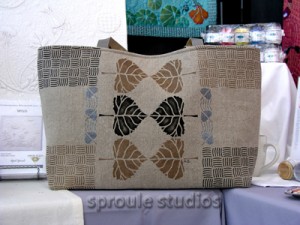
There are many other art supplies that can be used with stencils other than just textile paint. You can use stencils to apply a discharge medium to remove color. Many household cleaners that have a thicker consistency and also contain a bleaching agent like Soft Scrub with Bleach or one of the dishwasher detergents work well to remove the color from fabrics. However, any fabric that has been treated with bleach needs to be treated with something to neutralize the bleach. Anti-chlor works well for this purpose, and it is available through dye suppliers.
Resists can be applied through a stencil. Foils can also be added to your textiles by first applying a foil adhesive and then rubbing the foil substance on top of the adhesive. Laundering anything with an adhesive is not advisable. And last of all, you can use thickened dyes with stencils to apply images to your cloth.
I hope that you will consider adding the stenciling process to your existing repertoire of skills. Stencils are not only for walls and furniture; they are a technique for adding ornamentation and beauty to ever day objects which depict your own unique and original style. I believe we should enrich our lives by surrounding ourselves with beauty that makes us grateful for being alive.
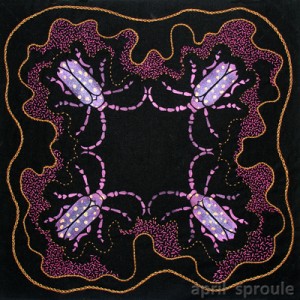
Web Resources:
Sproule Studios: www.sproulestudios.com
Sproule Studios Blog: www.sproulestudios.blogspot.com
April Sproule on Pinterest: http://www.pinterest.com/aprilsproule/stencils/
The “ Stencils” board contains many fine examples of Mariano Fortuny’s hand stenciled garments.
John Marshall: http://www.johnmarshall.to/
Helen Morris, UK : http://www.stencil-library.com/
Melanie Royals, CA: http://www.royaldesignstudio.com/
Books:
Carved Paper, Santa Barbara Museum of Art
Click here for the next article